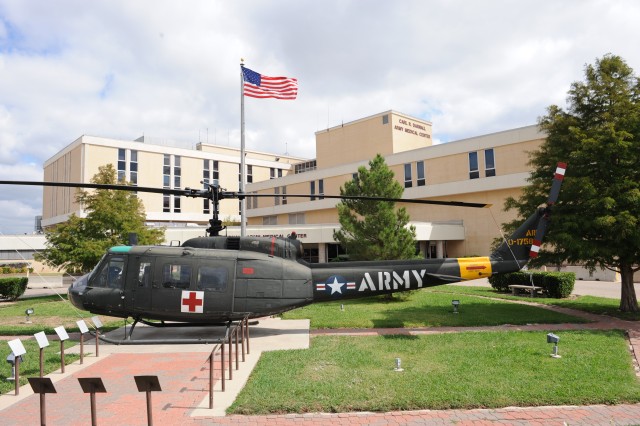FORT HOOD, Texas (March 27, 2009) -- A $621 million injection of federal stimulus money may assure construction of a new medical center at Fort Hood.
The current facility at the Killeen post opened in 1965 and was expanded in 1984, but has a shortage of operating rooms and, despite improvements, does not thoroughly meet the behavioral health care and other needs of Soldiers injured in the Global War on Terrorism.
Aca,!A"Past commanders of Darnall have been good stewards of taxpayersAca,!a,,c dollars with excellent upkeep of the existing building, but because of our expanding missions and patient base we have outgrown our buildings,Aca,!A? said Col. Casper Jones, commander, Carl R. Darnall Army Medical Center.
Aca,!A"The main hospital,Aca,!A? he emphasized, Aca,!A"cannot be further expanded. Repairs become more expensive over the years, to the point it is often less expensive to build than to repair or renovate. There comes a time when you cannot financially or physically make the building useable for todayAca,!a,,cs healthcare needs.Aca,!A?
With a center for behavioral health, he added, Aca,!A"We could provide better and more efficient services to Soldiers and their Families.Aca,!A?
Since the War on Terrorism began seven years ago, 500,000 Soldiers have deployed from Fort Hood. More than 2,200 wounded and ill Soldiers evacuated from Iraq and Afghanistan have passsed through the postAca,!a,,cs aging medical center, more than any other Army hospital and fewer than only Walter Reed and Eisenhower medical centers, according to the CRDAMC Web site.
As it has been Army-wide, the postAca,!a,,cs health care system has been strained, at times beyond its capacity, causing thousands of Soldiers wounded physically and mentally by the trauma of war especially those suffering from Post Traumatic Stress Disorders and Traumatic Brain Injuries to endure long waits for appropriate care locally or forcing their transfer to distant facilities, a considerable expense for the Army but one that also has imposed incalculable burdens on the wounded Soldiers and their Families.
Recently, Col. Bill Hill, the Fort Hood garrison commander, said, Aca,!A"The issue is, when Soldiers get injured in Iraq or Afghanistan, they end up at Fort Sam Houston.
Aca,!A"The Family is here,Aca,!A? he observed, Aca,!A"and oftentimes they have to travel down there (To San Antonio). If we had more robust capabilities here in Central Texas then, perhaps, we could get those Soldiers out of Brooke Army Medical Center and other facilities back here.Aca,!A?
The need for improved health care on post has been well documented. A report compiled by the Army indicates CRDAMC has made 16,000 referrals annually to BAMC at a cost of more than $2 million.
Although the medical center has significantly reduced the number of troops referred elsewhere for care during the past year, according to Col Bill Grimes, CRDAMC chief of staff, Aca,!A"WeAca,!a,,cre just trying to consolidate all of the behavioral health aspects that currently are scattered all over the campus.Aca,!A?
Grimes said the Department of Social Work DFAC, the Combat Reset Camp, TBI buildings and others have been modified Aca,!A"To provide better service to these Soldiers because, I think itAca,!a,,cs going to be depending upon mental health issues such as PTSD that are increasing and will continue to be services we need to provide our Soldiers.
The first phase of the new hospital should break ground in September 2010 and take about three years to complete, according to U.S. Representative Chet Edwards, D-Waco.
It will include 585,000 square feet with a primary care clinic, a pediatric clinic and new operating rooms. It also will include a behavioral health services facility that is now spread out in three separate locations on Fort Hood.
Edwards, who serves as chairman of the House Military Construction and Veterans Affairs Appropriations Subcommittee, said he authored $1.3 billion in the stimulus package for modernization of military hospitals.
He said recently Aca,!A"A significant part of those funds will be used to build the new hospital at Fort Hood.Aca,!A?
Before Phase II begins, the present Darnall facilities will be used for inpatient, emergency room and mothersAca,!a,,c health services, Edwards said.
Phase II will include an additional $350 million for a 362,000 square foot facility. Present plans are to start Phase II in 2016, Edwards said, adding, Aca,!A"I will work closely with Congressman Carter to see that Phase II is funded, and, if possible, funded before 2016.
When Phase II is completed, CRDAMC will be 71 percent bigger than the current hospital, or a total of 947,000 square feet.
The announcement of the new source of funds reflects decades of work by area congressmen and the postAca,!a,,cs commanders.
The $621 million comes out of the $1.3 billion that Edwards added for Department of Defense hospital modernization in the recent federal stimulus bill, according to the statement from Edwards.
Aca,!A"Trying to expand Darnall would cost more than building a new hospital,Aca,!A? said John Stone, a spokesman for U.S. Rep. John Carter (Rep.-TX). He said some of the testing and equipment areas for CT scans and MRIs are too small.
The new hospital is scheduled to be built where the Fort Hood Stadium now stands, he said.
The present Darnall facilities will continue to be used for in-patient care, an emergency room and health services for mothers until Phase II begins.
CRDAMC is one of the busiest medical treatment facilities in the Army, according to Edwards. On an average day, the staff handles 3,867 visits, 26 surgeries, 31 admissions, 170 emergency room visits and 5,000 prescriptions, he said.
It serves 55,000 active duty soldiers and 176,451 eligible beneficiaries. It was originally built to serve 17,000 troops.


Social Sharing